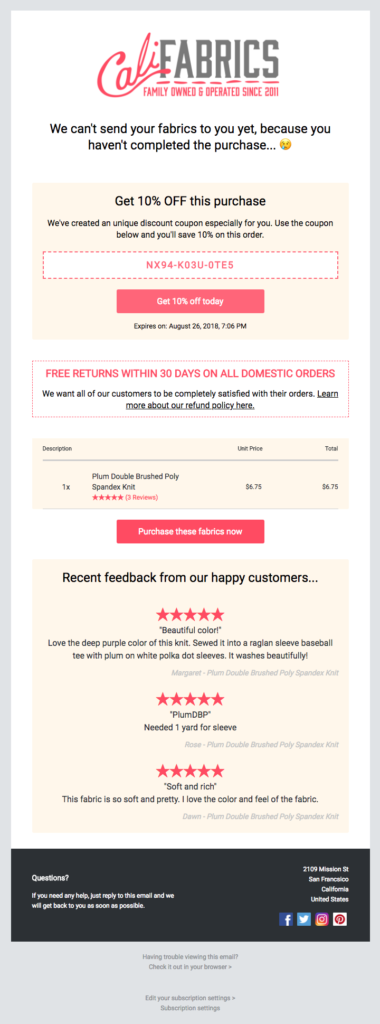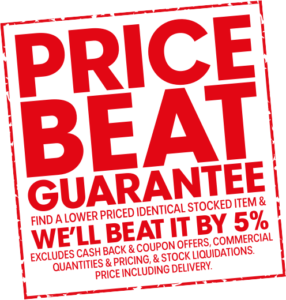As an eCommerce store owner, you might be aware of how prevalent cart abandonment is in the eCommerce space. It has been observed that the average cart abandonment rate across the entire eCommerce industry is 69.57%.
It’s frustrating to see visitors make up their mind to purchase a product, only to abandon their carts at the last moment for unknown reasons. Given the industry statistics, imagine the amount of potential customers e-stores loose on a daily basis!
Fortunately, there are a lot of conscious efforts you can take to save your store from a high abandonment rate. Once you get an insight into the customer’s psychology, you’ll be able to identify the reasons behind why they jilt the products they desire midway.
This article explores reasons for cart abandonment, and how you can counter them effectively.
Table of Content:
- What is Cart Abandonment?
- Common Reasons for Cart Abandonment
- Abandoned Cart Recovery: 9 Actionable Tips
- Lastly
What is Cart Abandonment?
Cart abandonment occurs when customers add products to their cart on an eCommerce store, but leave the website without making a purchase. This is a big challenge for many merchants, given the frequency with which it occurs and the ambiguity behind why a customer has not completed a purchase.
All online websites serve different customers with independent behavior patterns. There is no thumb rule as to why customers fail to place orders so frequently.
Several times, it’s simply because they’re window shopping and don’t actually intend to buy anything. Sometimes customers get distracted and never get around to completing their payment. Online shoppers are more careful and spend more time deliberating on their buying decisions, which is another reason for cart abandonment.
Often there are hurdles in the customer flow, preventing visitors from shopping for their desired product even though they want to. Abandoned cart recovery focuses on countering all these issues and knocking them out of your customer’s path.
Common Reasons for Cart Abandonment

1. Hidden or Additional Costs
Customers appreciate transparency, especially in pricing. Store owners often charge inflated taxes, packaging charges, delivery charges, and other extra fees, which discourages customers from making payment at the last step of the process. Sometimes these high charges are genuine, but consumers still might not be willing to pay.
Solution:
Provide additional cost information on the product page itself, so that consumers take an accurate estimation of the final amount into consideration while making their decision. Customers are more likely to conclude their purchase if they are prepared for the additional fees.
2. Poor Return Policy
Being able to return products if they are not satisfactory is what prompts customers to take the plunge and purchase something they have had no prior contact with. A sound return policy that assures customers of return and money refund is a must for any eCommerce business.
Solution:
Clearly state the time window customers have to test and return a product. Give them an option of a replacement, and also on how they would like to receive their money back. Make a ‘return policy’ page on your website that explains everything in detail and leaves no room for confusion.
3. Forcing to Create Account
Converting a customer is more important than getting them to sign up for your website. If you’re not an established brand, then first-timers will not be willing to make an account in order to shop on your website. Users first need to get acquainted with the shopping experience you provide. Only then will they be more inclined to make a permanent account on your website.
Solution:
Don’t force a customer to sign up. Give them an option to decline, or don’t ask for account creation in the first place.
4. Exorbitant Upselling
Upselling and cross-selling can help you sell more, but it can also distract your customers from their original purchase and irk them. Trying to convince your customers to buy more when they’re already making a purchase can go against you.
Solution:
Analyze consumer reaction on cross-promotion tactics and try to strike a balance. You should be able to cross-sell without losing customers. Don’t clutter the customer’s brain with too many options and place your suggestions in a subtle way so that they look genuine.
5. Poorly Optimized Checkout Procedure
Most cart abandonment happens during the checkout procedure, when the customer is about to make payment. This could happen for two main reasons:
- Complicated checkout procedure: Sometimes the checkout procedure is confusing, long, and tricky to navigate. If your checkout page is cluttered and involves too many redirects, then your customers may be deterred to complete their payment.
- Lack of payment options: Customers are very picky with payment methods online and like to stick to the one they think is the most reliable. If that option is not available, they will prefer to not go through with the payment.
Solution:
- Look for one step checkout extensions and try to make your checkout procedure effortless for customers. For example, use an algorithm or gateway that automatically picks the OTP sent on the customer’s phone, instead of asking them to manually put it in.
- Research on the most commonly used payment methods. Apart from credit/debit cards, allow payments through COD, EMI, e-wallets, etc.
6. High cap for Free Shipping
Shipping charges will immediately make your customers abandon their carts. eCommerce stores set a minimum shopping amount, below which shipping charges are applicable. If customers usually shop for less on your store, they will neither be willing to spend more just to avail free shipping or pay the high shipping amount, resulting in them leaving their carts.
Solution:
Try to charge minimal for shipping if possible. Determine the average amount customers spend when shopping on your store, and set a limit accordingly. If customers shop for no more than $20 on your store, then it’s foolish to ask them to shop for a total of $60 to avail free shipping.
Interesting read: 23 eCommerce Conversion Rate Optimization Tips to Increase your Customer Base
Abandoned Cart Recovery: 9 Actionable Tips
1. Show Savings at Checkout
Always show how much customers are saving on every purchase. This subconsciously makes the customer feel like they’re making a rational purchase, and that too at a competitive price, which in turn motivates them to place an order.
Always include all discounts that you’re giving on your product. If you’re offering free shipping and zero packaging charges, then display those too.
2. Send Compelling Reminders
Customers of today are extremely distracted. Often they’ll abandon carts because something else has caught their attention, and then they never get around to making the purchase. You can’t really do anything about these external factors, but sending persuasive reminders could help bring customers back.
Send emails that include the products they have left in their cart, and make it sound casual and catchy. Remember to include a button that takes them to their cart or your website. Here’s an example;
Dyson has also included reasons to shop with their brand, which could induce customers to rethink their decision and go back to their cart. You can also add details on the product itself, and the value it could bring to the customer. If you’re introducing any coupons or discounts on the product, then including those would make for a great incentive.
3. Show an Exit Intent Pop-up
Displaying a pop-up when your customers are just about to leave your store could make them rethink their decision, and they might not abandon their cart at all. The purpose of this is to give it one last try and convince your customers to stay.
Your exit-intent popup scan include:
- Statements asking customers to rethink their decision to abandon
- Discount coupons or offers on your products
- A message requesting them to come back soon
- If you’re offering in shipping or additional cost relaxations
4. Create a Sense of Urgency
Sometimes customers leave because they’re still contemplating their purchase decision. They could also be waiting for the product price to fall. Send an email or app notification reminding them of the content in their carts, and also inform them that those products are selling fast and may be of stock soon.
You can also display an ‘only 2 left in stock’ detail beside the product in the cart itself so that the customer doesn’t unnecessarily delay their purchase.
5. Targeted Ads
You can re-target lost shoppers through ads. Leverage Instagram and Facebook and run ads for the exact products customers have left in their carts. For this, you need to capture some detail about the customer, their geographical area, Gmail account, name, etc. Re-targeting ads will remind customers of the products they want to buy.
If you include some incentive (discounts, relaxations, new offers, etc), then they might click on it immediately and come back to your website. You can also create a sense of urgency by telling them that only a few items are left in stock.
6. Include User Generated Content
If your customer has stranded her cart because she’s unsure of the product or not convinced if it’s the best choice available, then user-generated content can establish trust and assure her of the product’s quality by providing social proof.
You can include:
- Star ratings that verified buyers have given
- Product feedback they have left on your website
- Images they have shared along with the views
- Reasons why customers have gone and purchased your product

7. Time Your Emails Right
You might have put a lot of thought into crafting the perfect abandoned cart recovery email; one that is subtle yet effective, and has high chances of a satisfactory click-through rate. But, even that might fail if the timing isn’t right.
Sending the email immediately after a customer has left could be ineffective. Whereas waiting for too long would mean you risk losing the customer as he/she might end up shopping elsewhere.
Your abandoned cart recovery email should hit your customer’s inbox within 2 days of cart abandonment. A 2-3 day window is safe, it doesn’t give the impression that you’re trying too hard to urge your customer. Neither does it risk losing the customer altogether.
8. Highlight your Competitive Price
Assuring customers that the price you are quoting is the best they will find in the market, is a great psychological trick. It gives them a sense of reliability and clears any doubts they might have about the purchase.
A lot of brands show price comparison, where they compare the prices and specifications of similar products or products of other brands. This is a cogent way to appeal to your customer’s decision making, nudging them towards the next step on your sales funnel.
You could also give a price beat incentive. If a customer finds any other seller offering the same product for a lower price, you will offer a price relaxation in return.

9. Ask for Feedback
Sending an abandoned cart recovery email in the guise of a feedback query will kill two birds with one stone; it will remind your customers of the products they have left in their cart and you might get an insight into the apprehensions that are restricting them from placing an order.
My advice would be to include answer options along with the questions in the email itself, so that all customers have to do is click the most relevant option. If you ask them to visit your site for feedback, they might not make the effort. This way, you can enhance the customer experience you’re offering. And who knows, you might end up solving problems of multiple customers who are facing the same issues.
Lastly…
Try to identify the problem first and then adopt a solution accordingly. Conduct A/B testing and analyze user behavior on your site, especially on the checkout page. You’ll be able to recover customers more effectively if you work to solve the precise problem that is affecting them.
Abandoned cart recovery might seem like a complicated affair and a little less credible in terms of success rate, but it works for most eCommerce businesses, given you execute it right. If you have any queries, please feel free to comment below!
Read: 6 eCommerce Storytelling Tips to Master your Brand’s Story

Divya loves writing and is passionate about marketing. When not trying to hone her skills, you’ll find her either reading or binging on TV shows.

0 Comments